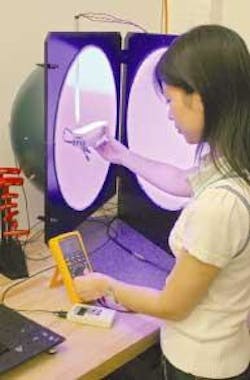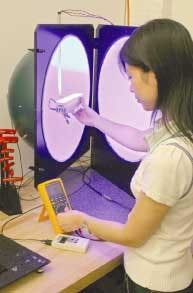Redirected backscattered photons boost LED efficiency
As they inch their way toward producing more-practical light-emitting-diode (LED) illumination sources, solid-state-lighting researchers know that even small improvements in the efficiency of white LEDs are big news. At 20 to 30 lm/W, today’s white LEDs already surpass the 14‑lm/W efficiency of typical incandescent lamps, but they still lag far behind the 60-lm/W efficiency of compact fluorescent lamps. The sum of many incremental advances is what will likely push LEDs to the upper reaches of efficiency.
But sometimes these advances can be rather large, as Nadarajah Narendran, director of research at Rensselaer Polytechnic Institute’s Lighting Research Center (LRC; Troy, NY), and his group have proven. A typical white LED is a combination of a blue semiconductor emitter and yellow phosphor; by redesigning the geometry of the phosphor volume such that backscattered light is redirected outward, the LRC group has boosted white-LED efficiency by 30% to 60%.1
In an ordinary white LED, the phosphor is contained in the epoxy resin that encapsulates the LED die, and in some high-output white LEDs the phosphor exists as a thin coating directly on the die, the whole of which is encapsulated in silicone. In either case, a significant amount of backscattered photons produced by the phosphor are intercepted by the die and are blocked from exiting the LED, reducing efficiency. The LRC scattered-photon-extraction (SPE) LED solves this problem by spacing the phosphor layer away from the die and optically redirecting the backscattered light.
Experimental results
In a first experiment, a flat 5‑cm-diameter phosphor-coated plate was spaced 2.5 cm away from a blue-emitting LED. The phosphor plate was placed at the junction between two integrating spheres (see figure). With the LED illuminating the plate, one sphere measured the transmitted and forward-scattered light, while the other measured the backscattered light. Only about 40% of the luminous flux was transmitted, with the remaining flux scattered back toward the die-clearly illustrating the backscatter problem.
Next, a series of SPE LEDs was created in which commercial transparent optical elements were placed over LEDs; the outer flat surfaces of the optics were coated with phosphor layers, allowing backscattered light to exit the optics and then be redirected forward by an external fixture. Although acceptable for the experiment, the chosen commercial optic had less-than-optimum geometry. Twelve packages-six with 3-W blue LEDs and, for comparison, six with 3-W white LEDs (and no phosphor layers)-were constructed.
When run at equal power, the packages with conventional white LEDs produced 56.5 lm and 22.6 lm/W and the SPE LED packages produced an average of 90.7 lm and 36.3 lm/W-a 61% higher luminous efficacy.
Because the efficacy of LEDs tends to increase as the current is lowered, the group chose one conventional and one SPE LED to see what they could do at their most efficient. At very low currents, the conventional LED produced 54 lm/W-a very high figure-but the SPE LED bettered that, reaching an 80-lm/W efficacy. Although the light output at this current was too low to be practical, the results are relevant because, with improved heat management, the devices can provide high efficacy at higher currents, notes Narendran.
The group has built a prototype light fixture about 2 × 2 × 10 in. long containing six SPE LEDs-a rough prototype that could be made much smaller, says Narendran. The fixture is capable of producing 36 to 78 lm/W and greater than 500 lm at its rated current, he notes. They are also designing improved optical geometries and are pursuing patents on their idea.
REFERENCE
1. N. Narendran et al., physica status solidi (a)202(6) R60-R62 (2005) / DOI 10.1002/pssa.200510015.

